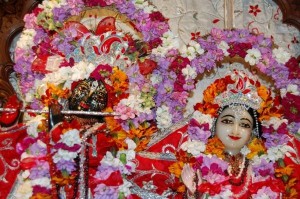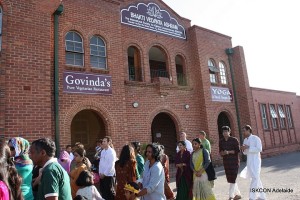20 August ’14 Sringar Darshan at ISKCON Juhu, Sri Sri Radha Rasabihariji Temple
20 August ’14 Sringar Darshan at ISKCON Juhu
Prabhupada Vyasapuja offering at Radha Gopinath temple
→ The Spiritual Scientist
Gita Nagari Farm Listed as Success Story by US Department of Agriculture
→ ISKCON News
Hare Krishnas Cannot Solicit Donations at Los Angeles Airport
→ ISKCON News

A ban on soliciting donations at Los Angeles International Airport (LAX) does not tread on Hare Krishna members' free speech rights, the 9th Circuit ruled Wednesday. A city ordinance forbids the immediate solicitation of money at Los Angeles International Airport (LAX), including the terminals, the parking lots, and adjacent sidewalks.
Festival of the Chariots on the Island of the Gods
→ ISKCON News

"The International Society for Krishna Consciousness for Indonesia has been celebrating Ratha-yatra festival for twelwe years,” Bala Krishna das head of this year’s Ratha Yatra committee says. "Every year the festival changes its location, moves from regency to regency within Bali. Now, after twelwe years, we have reached a full circle, and the festival arrived back in Bali's provincial capital Denpasar."
Jagannath Festival- Advertisement in a Tamil Television station
→ ISKCON Scarborough
HH Bhakti Purushottam Swami – The pastimes of Srimati Radharani
→ Kalachandji's Audio Archive
HH Bhakti Sundar Goswami / SB 10.69.13-15
→ Kalachandji's Audio Archive
Govindas Adelaide
→ Ramai Swami
Govindas Restaurant in Adelaide in situated in the temple itself to the left as you walk in. At the moment it is open only three nights a week but it is proving so popular that the devotees want to increase to more days.
Our Own Worst Enemy
→ Karnamrita.das's blog
(this blog is recorded on the full page: quick time player is needed; works best with Firefox or Explorer; if you are using Google Chrome it will automatically play, so if you don't want to listen, mute your speakers.)

Stuck in an airport with a delayed flight I struck up a conversation with a business person:
“You want to know a secret?’
“Maybe?”
“I’ll take that as a yes. You are often your own worst enemy.”
Getting his attention, he turned toward me and said: “I think many people know this.”
“True, but there is another part to this secret: Most people don’t do anything about this, and aren’t motivated to change, or believe they can.”
Reaching into my computer case I take out some writing I did.
“What papers do you have there?”
“I wrote a blog on the topic of being our worst enemy, and what to do about it…want to read it?”
“Sure, looks like we have a few hours to kill, and besides, [the clincher, I guess] the Wi-Fi is down.”
“Let me know what you think.”
Our Own Worst Enemy
As I was thinking of the topic for this blog I found a graphic illustration to demonstrate what I wanted to say. Every week I go shopping to pick up organic veggies at a garden supply shop about 20 minutes from here. Sometimes there is a beautiful, young, though full grown, German Sheppard dog. Though he used to lazily lie around the shop, and then come closer wagging his tail to get petted, now he has taken up the startling, and for some, frightening, habit of barking loudly at shoppers—which hasn’t been real good for business. As a result he is now kept in a cage in the corner.
Please Remind Me
→ Japa Group
Letter to Devananda 1968
The power of purity
→ KKSBlog
(Kadamba Kanana Swami, 04 October 2013, Melbourne, Australia, Srimad Bhagavatam 2.2.9)
 Prabhupada many times said, “A society of cats & dogs.” Some of his favourite sayings were rascal and cats & dogs. Prabhupada had the power to call people rascals because in front of him, everyone could realize, “I am a rascal.”
Prabhupada many times said, “A society of cats & dogs.” Some of his favourite sayings were rascal and cats & dogs. Prabhupada had the power to call people rascals because in front of him, everyone could realize, “I am a rascal.”
Ravindra Svarup das brought a professor of Hinduism who was introduced to Prabhupada. Prabhupada asked him what the definition of Hinduism was. The professor said, “That is hard to say.” Prabhupada turned to Ravindra Svarupa, “What would you call that… Cheating!”
Prabhupada said, “That is right, cheating!” Professor cannot give a definition of Hinduism. Then, in moments, they had serious argument. They were raising their voices to each other and then Brahmananada, who used to be a wrestler, he came up to the professor and said, “You better get out of here before you make more offences!”
The professor looked at him and got the point. He just got up and left. Twenty years later, Ravindra Svarup das met the professor. He said, “Oh, do you remember when I met Swami Bhaktivedanta!” Ravindra Svarup was about ready to sink into the ground. Then the professor said, “You know, he was right!”
So that is the power of purity. Then one can say rascal and one can do so many things.
Beautiful Janmastami Play 2014 San Diego, CA (11 min video)
→ Dandavats.com
 This video is about The killing of Aghasura. The Krishna kids of San Diego perform a nice play for the pleasure of the Lord and His devotees. Read more ›
This video is about The killing of Aghasura. The Krishna kids of San Diego perform a nice play for the pleasure of the Lord and His devotees. Read more › “Permanently Infected,” Vyasa-puja Evening, August 18, New Dvaraka, Los Angeles
Giriraj Swami
 Devotees met in Srila Prabhupada’s quarters in the evening for an intimate sharing of Srila Prabhupada memories.
Devotees met in Srila Prabhupada’s quarters in the evening for an intimate sharing of Srila Prabhupada memories.
“My parents invited a family friend who was a psychologist. She came in my room and began to inquire, ‘Tell me, Glenn, did you feel that your parents didn’t love you?’ ‘Which parents?’ I asked. ‘I have passed so many lifetimes, and in every lifetime I have had different parents.’ It went on like this for some time, and she left the room. Then I overheard her speaking with my parents. ‘I am sorry, I but I don’t think there is anything I can do.’ Then I realized that she had come to ‘cure’ me. When I related this incident to Srila Prabhupada here, he responded, ‘Yes, you have been permanently infected; you can never be cured.’ ”
Bhaktivedanta College’s Dean of Studies Takes Sannyasa
→ ISKCON News

ISKCON-guru and well-known academic, Krishna Kshetra Das (Dr. Kenneth R. Valpey) took sannyasa (entered the renounciate order) at Goloka Dham, Germany, on Janmastami, 2014. His new name now is Krishna Kshetra Swami. An interview about his academic activities, upcoming book projects and future plans.
Janamastmi Celebrations and A Swan like Vyasasasan for Paramhamsa Srila Prabhupada on Vyaspuja Day@ISKCON Punjabi Bagh (Album 201 photos)
→ Dandavats.com
 Devotees worked hards to create a Swan Vyasasan for Srila Prabhupada. There was also an exhibition on life of Srila Prabhupada.
Go Puja, Abhishek, Glorification, Puspanjali culminating in feast Prasadam for everyone. AGTSP. Read more ›
Devotees worked hards to create a Swan Vyasasan for Srila Prabhupada. There was also an exhibition on life of Srila Prabhupada.
Go Puja, Abhishek, Glorification, Puspanjali culminating in feast Prasadam for everyone. AGTSP. Read more › New Jersey, USA, Welcomes BAPS Hindu Temple
→ ISKCON News

The new Shri Swaminarayan Mandir covers 160 acres, and the primary mandir, or temple, on the premises measures 133 ft long and 87 ft wide.
Yoga Legend BKS Iyengar Passes Away
→ ISKCON News
How Many Lives Have You Lived?
→ ISKCON News
Somvati Amabasya! Bhandrivan! Vrindavan 25/8/14 (Album 29 photos)
→ Dandavats.com
 Somvati Amavasya 2014 occurs on August 25, 2014. It is the darkest day of the month and many people observe a fast on this day. Read more ›
Somvati Amavasya 2014 occurs on August 25, 2014. It is the darkest day of the month and many people observe a fast on this day. Read more › August 26th, 2014 – Darshan
→ Mayapur.com
The post August 26th, 2014 – Darshan appeared first on Mayapur.com.
Bh. Peter asks how Brahma stole the gopas from Goloka – strange -, Tarun Krsna whether milk is spiritual
→ SivaramaSwami.com
Vraja-kumara about karma and Govardhana dasa questions about store bought milk.
The post Bh. Peter asks how Brahma stole the gopas from Goloka – strange -, Tarun Krsna whether milk is spiritual appeared first on SivaramaSwami.com.
ISKCON Alachua: where every single aspect, from flower decorations, to cooking, pot washing and more, is done out of love!
→ Dandavats.com
 Mukhya devi dasi: The Summer Festival season is winding down, ending with our most beloved Radhastami Festival on Tuesday, September 2, 2014. Is it possible that every year these celebrations get better and better? That's how it seems to me. More devotees coming on board using their time and talents, new people taking on services, increasing the quality and results. For a few hours, we were swept away to the spiritual world, kirtans in every corner with devotees taking part in a variety of transcendental engagements. There were devotees glorifying the Lord in dance, drama and song, in sumptuous prasadam and Deity worship and many expressions of loving service. Read more ›
Mukhya devi dasi: The Summer Festival season is winding down, ending with our most beloved Radhastami Festival on Tuesday, September 2, 2014. Is it possible that every year these celebrations get better and better? That's how it seems to me. More devotees coming on board using their time and talents, new people taking on services, increasing the quality and results. For a few hours, we were swept away to the spiritual world, kirtans in every corner with devotees taking part in a variety of transcendental engagements. There were devotees glorifying the Lord in dance, drama and song, in sumptuous prasadam and Deity worship and many expressions of loving service. Read more › Is the universal form in the Gita’s ninth chapter a conceptualization and the eleventh chapter, a revelation?
→ The Spiritual Scientist
From Revati Vallabha Prabhu
What does the Gita’s inverted tree metaphor signify?
→ The Spiritual Scientist
How is the world a lila of the Pursha avatara? Is it a virtual reality manufactured by him with chosable scripts for us?
→ The Spiritual Scientist
From Muralidhara Prabhu:
I wonder how the realisation of this material world being a lila of Purusha Avatar will fit into the illusion concept. Can we say that the world is a Virtual Reality (the dream world of MahaVishnu) with the characters having the capacity to write their own script?
Can we reconcile this to the inverted tree concept of Chapter 15?
When everything is in Prabhupada’s books, what is the need to read other books either by ISKCON devotees or previous acharyas?
→ The Spiritual Scientist
Former Neighbours star Erin Mullaly, right, is now heavily involved in the Hare Krishna community
→ Dandavats.com
 Erin Mullaly: “I started volunteering at a not for profit cafe down in Cronulla and from there I was introduced to more and more of the spiritual aspects in terms of self realisation and higher purpose and I found that really attractive and interesting. “I think it is sort of balancing my life out you know of somewhat materialistic with the money and the name and stuff so it is rebalancing.” Read more ›
Erin Mullaly: “I started volunteering at a not for profit cafe down in Cronulla and from there I was introduced to more and more of the spiritual aspects in terms of self realisation and higher purpose and I found that really attractive and interesting. “I think it is sort of balancing my life out you know of somewhat materialistic with the money and the name and stuff so it is rebalancing.” Read more › Does Prabhupada’s instruction ‘do as I have done’ mean there’s no need to innovate in preaching”
→ The Spiritual Scientist
Iskcon devotees engage in weekly prasadam distribution to the needy people of Genoa, Italy (Album 9 photos)
→ Dandavats.com
 It is not only in India-all over the world. There cannot be peace unless you reform the whole social structure, and that can be done only by this Krishna consciousness. Surat, January 3, 1971. Read more ›
It is not only in India-all over the world. There cannot be peace unless you reform the whole social structure, and that can be done only by this Krishna consciousness. Surat, January 3, 1971. Read more › IRKUTSK Oblast, Russia, Siberian Hare Krisha Festival 2014 (Album 115 photos)
→ Dandavats.com
 A person who chants the holy name of the Lord, even if born in a family of candalas, dog-eaters, does not need reformation. Simply by chanting Hare Krishna, he immediately becomes purified and becomes as good as the most learned brahmana. (Srimad-Bhagavatam, 3.26.61 Purport) Read more ›
A person who chants the holy name of the Lord, even if born in a family of candalas, dog-eaters, does not need reformation. Simply by chanting Hare Krishna, he immediately becomes purified and becomes as good as the most learned brahmana. (Srimad-Bhagavatam, 3.26.61 Purport) Read more › Meet the devotees, temple grounds and prasadam products of the Alachua Hare Krishna community (Album 169 photos)
→ Dandavats.com
 Lord Caitanya Mahaprabhu recommended five items of devotional service, namely to serve the devotees of the Lord, to chant Hare Krishna, to hear Srimad-Bhagavatam, to worship the Deity of the Lord and to live in a place of pilgramage. (Srimad-Bhagavatam, 3.19.38 Purport) Read more ›
Lord Caitanya Mahaprabhu recommended five items of devotional service, namely to serve the devotees of the Lord, to chant Hare Krishna, to hear Srimad-Bhagavatam, to worship the Deity of the Lord and to live in a place of pilgramage. (Srimad-Bhagavatam, 3.19.38 Purport) Read more › San Fracisco Ratha-yatra & Festival Of India (Album 89 photos)
→ Dandavats.com
 The powerful hari-nama is so strong that even if one unconsciously or consciously they imitate; "Hare Krishna." They have no intention to chant the holy name of Krishna, but they imitate or criticize, "Hare Krishna." That also has effect. Calcutta, January 10, 1971. Read more ›
The powerful hari-nama is so strong that even if one unconsciously or consciously they imitate; "Hare Krishna." They have no intention to chant the holy name of Krishna, but they imitate or criticize, "Hare Krishna." That also has effect. Calcutta, January 10, 1971. Read more › HH Bhakti Vidyapurna Swami at ISKCON Mayapur on 2014-08-24
→ Gouranga TV - The Hare Krishna video collection
HH Bhakti Vidyapurna Swami at ISKCON Mayapur on 2014-08-24, Srimad Bhagavatam Canto 05 21 04 11
How do we decide which of our emotions are material and which are spiritual?
→ The Spiritual Scientist
Is a devotee’s grihastha-ashrama a failure if the children don’t become devotees?
→ The Spiritual Scientist
Why do Abrahamic religions depict God as jealous when they are too are revelations?
→ The Spiritual Scientist
Is the prayer to get a good spouse a material prayer?
→ The Spiritual Scientist
It is said that we should not pray to Krishna for material things, but what about those material things that are very important for our spiritual life such as getting a good spouse. Can we pray to Krishna for them?
Prabhupada Letters :: Anthology 2014-08-26 04:26:00 →
Prabhupada Letters :: 1947-64
Prabhupada Letters :: Anthology 2014-08-26 04:19:00 →
Prabhupada Letters :: 1968







